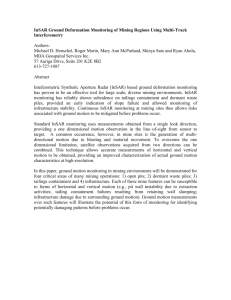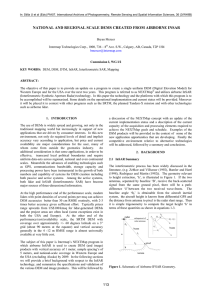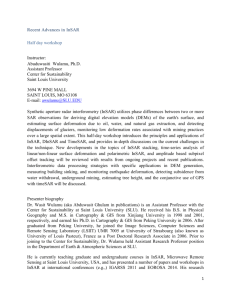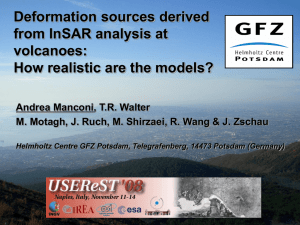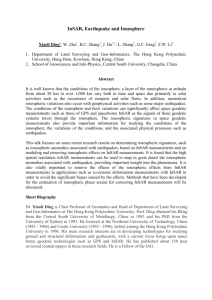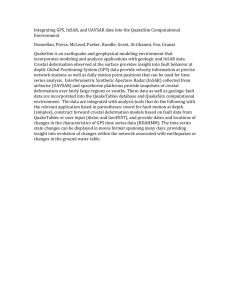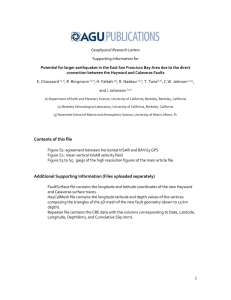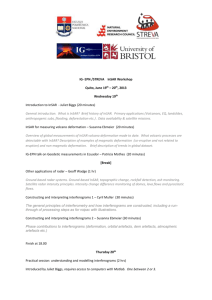RECENT ADVANCES IN AIRBORNE INSAR FOR 3D APPLICATIONS
advertisement
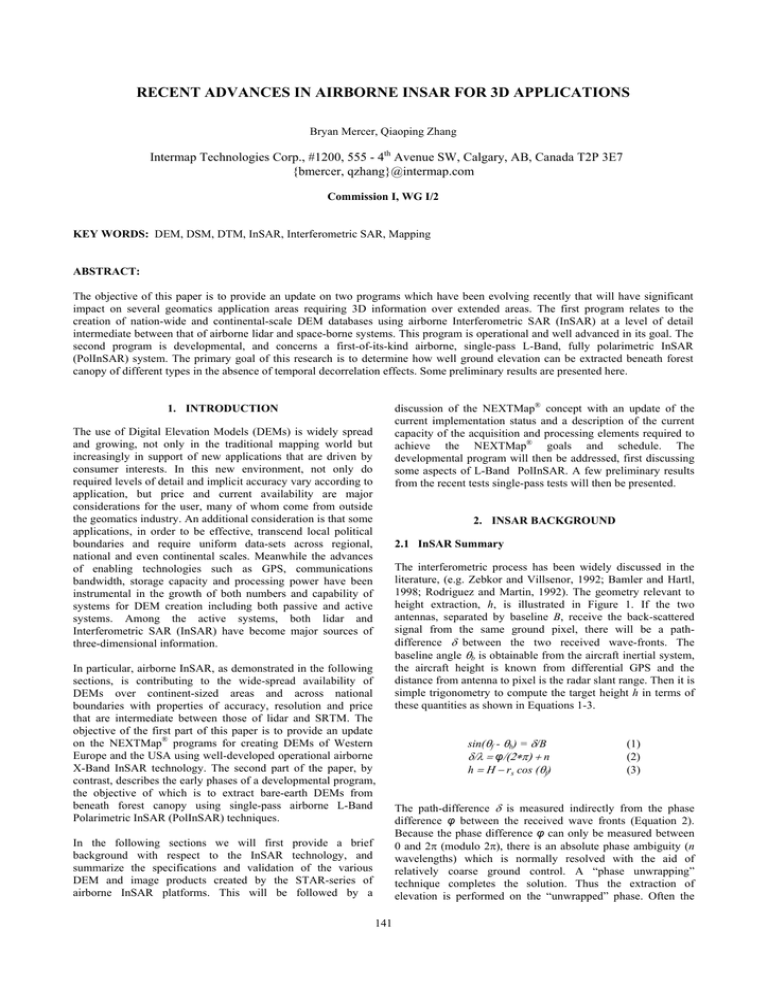
RECENT ADVANCES IN AIRBORNE INSAR FOR 3D APPLICATIONS
Bryan Mercer, Qiaoping Zhang
Intermap Technologies Corp., #1200, 555 - 4th Avenue SW, Calgary, AB, Canada T2P 3E7
{bmercer, qzhang}@intermap.com
Commission I, WG I/2
KEY WORDS: DEM, DSM, DTM, InSAR, Interferometric SAR, Mapping
ABSTRACT:
The objective of this paper is to provide an update on two programs which have been evolving recently that will have significant
impact on several geomatics application areas requiring 3D information over extended areas. The first program relates to the
creation of nation-wide and continental-scale DEM databases using airborne Interferometric SAR (InSAR) at a level of detail
intermediate between that of airborne lidar and space-borne systems. This program is operational and well advanced in its goal. The
second program is developmental, and concerns a first-of-its-kind airborne, single-pass L-Band, fully polarimetric InSAR
(PolInSAR) system. The primary goal of this research is to determine how well ground elevation can be extracted beneath forest
canopy of different types in the absence of temporal decorrelation effects. Some preliminary results are presented here.
discussion of the NEXTMap® concept with an update of the
current implementation status and a description of the current
capacity of the acquisition and processing elements required to
achieve the NEXTMap® goals and schedule. The
developmental program will then be addressed, first discussing
some aspects of L-Band PolInSAR. A few preliminary results
from the recent tests single-pass tests will then be presented.
1. INTRODUCTION
The use of Digital Elevation Models (DEMs) is widely spread
and growing, not only in the traditional mapping world but
increasingly in support of new applications that are driven by
consumer interests. In this new environment, not only do
required levels of detail and implicit accuracy vary according to
application, but price and current availability are major
considerations for the user, many of whom come from outside
the geomatics industry. An additional consideration is that some
applications, in order to be effective, transcend local political
boundaries and require uniform data-sets across regional,
national and even continental scales. Meanwhile the advances
of enabling technologies such as GPS, communications
bandwidth, storage capacity and processing power have been
instrumental in the growth of both numbers and capability of
systems for DEM creation including both passive and active
systems. Among the active systems, both lidar and
Interferometric SAR (InSAR) have become major sources of
three-dimensional information.
2. INSAR BACKGROUND
2.1 InSAR Summary
In particular, airborne InSAR, as demonstrated in the following
sections, is contributing to the wide-spread availability of
DEMs over continent-sized areas and across national
boundaries with properties of accuracy, resolution and price
that are intermediate between those of lidar and SRTM. The
objective of the first part of this paper is to provide an update
on the NEXTMap® programs for creating DEMs of Western
Europe and the USA using well-developed operational airborne
X-Band InSAR technology. The second part of the paper, by
contrast, describes the early phases of a developmental program,
the objective of which is to extract bare-earth DEMs from
beneath forest canopy using single-pass airborne L-Band
Polarimetric InSAR (PolInSAR) techniques.
In the following sections we will first provide a brief
background with respect to the InSAR technology, and
summarize the specifications and validation of the various
DEM and image products created by the STAR-series of
airborne InSAR platforms. This will be followed by a
141
The interferometric process has been widely discussed in the
literature, (e.g. Zebkor and Villsenor, 1992; Bamler and Hartl,
1998; Rodriguez and Martin, 1992). The geometry relevant to
height extraction, h, is illustrated in Figure 1. If the two
antennas, separated by baseline B, receive the back-scattered
signal from the same ground pixel, there will be a pathdifference δ between the two received wave-fronts. The
baseline angle θb is obtainable from the aircraft inertial system,
the aircraft height is known from differential GPS and the
distance from antenna to pixel is the radar slant range. Then it is
simple trigonometry to compute the target height h in terms of
these quantities as shown in Equations 1-3.
sin(θf - θb) = δ/B
δ/λ = φ/(2∗π) + n
h = Η − rs cos (θf)
(1)
(2)
(3)
The path-difference δ is measured indirectly from the phase
difference φ between the received wave fronts (Equation 2).
Because the phase difference φ can only be measured between
0 and 2π (modulo 2π), there is an absolute phase ambiguity (n
wavelengths) which is normally resolved with the aid of
relatively coarse ground control. A “phase unwrapping”
technique completes the solution. Thus the extraction of
elevation is performed on the “unwrapped” phase. Often the
The International Archives of the Photogrammetry, Remote Sensing and Spatial Information Sciences. Vol. XXXVII. Part B1. Beijing 2008
accuracy specifications as illustrated in Table 1 below. It is
worth noting that all four of the STAR family of sensors are
able to achieve these product specifications despite the nuance
of individual system design or platform specifics. Apart from
these core specifications, other accuracies and image/DEM
resolutions can be supported to meet specific requirements.
Optical/radar merged products are now also becoming available
as exemplified in Section 3.
InSAR is operated in a so-called ping-pong mode which
effectively doubles the value of the geometric baseline B. These
equations become the basis for sensitivity and error analysis
(e.g. Rodriguez and Martin, 1992). For single-pass InSAR
airborne systems as described in this work, the signals are
received almost simultaneously so that errors induced by
temporal-decorrelation are not a factor as is the case for satellite
systems such as ERS and Radarsat which operate in a repeatpass mode. Provided the baseline length, position (from DGPS)
and attitude (from coupled GPS/inertial) are adequately
controlled and/or measured, the dominant noise-like error
source arising out of these sensitivity equations is ‘phase noise
σφ’ so that the signal-to-noise ratio, which is a function of
flying height among other system-related factors, becomes a
means of (partly) controlling height error specifications. That is,
other parameters being fixed, the height noise will increase as a
function of flying height. For example, DEMs created from the
STAR-3i system, when operated at about 9km altitude, has a
height-noise level of about 0.5 m (1 sigma, 5 m sample spacing)
at the far edge of the swath. Systematic errors, with reference to
STAR-3i DEMs, are usually slowly-varying and arise from a
variety of sources but are limited through calibration,
operational and processing procedures
Figure 2. Clockwise from upper left: STAR-3i, STAR-4,
STAR-6 and STAR-5.
Product
Type
I
II
III
DSM
RMSE Spacing
0.5
5
1
5
3
10
DTM
RMSE Spacing
0.5
5
1
5
-
Table 1. Intermap Core Product specifications for InSAR
DSMs and DTMs. All units are meters. RMSE refers to vertical
accuracy and is with respect to terrain that is moderately sloped,
bare (DSM) and unobstructed. DTM specifications apply to
areas for which the forest or other above ground cover is
‘patchy’ to a maximum scale of about 100 meters. Details of
these specifications may be found at www.intermap.com.
Figure 1. Schematic of Airborne IFSAR Geometry.
2.2 Current Intermap Airborne InSAR Systems
2.4 Operational Components
In order to meet the schedule requirements of its NEXTMap®
program (Section 3) and other demands, Intermap has recently
developed three additional operational airborne InSAR systems
(Figure 2) to supplement the acquisition capability of the
STAR-3i® system. STAR-3i, is an X-band, HH polarization
InSAR flown on a Learjet 36 (Tennant and Coyne, 1999). In the
last few years, all of the software and most of the hardware has
been replaced in order to improve product quality and
efficiency of operation. The new systems are based on a
common architecture and are flown in 2 King Air and 1 Lear Jet
platforms respectively. The systems are described in somewhat
greater detail in Chapter 6 of (Maune, 2007). The addition of
these systems has greatly improved scheduling flexibility and
capacity.
The operational flow consists of four major stages: (1) planning
and acquisition, (2) interferometric processing, (3) editing and
finishing, and (4) Independent Quality Control, after which the
data are delivered to the data base repository. The operational
concept has evolved to accommodate the requirements imposed
by the current NEXTMap® goals as well as custom projects.
The NEXTMap® Europe and USA objectives alone require the
data acquisition for an area incorporating 10.2 million km2 by
the end of 2008. All aspects of production are managed with
rigorous QC checks throughout and within the framework of
ISO9000 certification.
3. NATIONAL MAPPING PROGRAMS: NEXTMAP
2.3 Product Specifications
NEXTMap® is the term used by Intermap to describe its
InSAR-based national and regional mapping programs.
Specifically the concept is to make DSM, DTM and ORI
products generally available in a seamless fashion over national
and trans-national regions where multiple applications and
markets may benefit. By retaining ownership and licensing the
data to multiple users, the cost is shared, making it feasible for
public and private organizations to have access to these data
The core InSAR products available from Intermap’s online
store include an Ortho-rectified Radar Image (ORI), a Digital
Surface Model (DSM) and the bare earth Digital Terrain Model
(DTM). X-band images are at 1.25-m resolution with similar
horizontal accuracy. DSM and DTM are posted at 5m spacing.
The elevation products are available in three standard vertical
142
The International Archives of the Photogrammetry, Remote Sensing and Spatial Information Sciences. Vol. XXXVII. Part B1. Beijing 2008
sets in whole or part. The Type II specification for the DSM
creates a level of detail (1m RMSE vertical accuracy, 5 meter
sample
spacing)
intermediate
between
lidar
or
photogrammetrically-produced products on the one hand, and
SRTM or SPOT5 products on the other. The associated ORI
carries a resolution of 1.25 m and horizontal accuracy less than
2m RMSE.
4. SINGLE-PASS L-BAND POLINSAR SYSTEM
4.1 Introduction
As noted earlier, X-Band and C-Band InSAR, which are the
major sources of DEM data from airborne and satellite
platforms respectively, are usually measuring the elevation of
the upper part of the canopy, not the ground below. At longer
wavelengths (L-Band and P-Band), attenuation is less but can
still be appreciable (Bessette and Ayasli, 2001). The received
backscatter signal comprises both canopy and ground
components and the interferometric phase difference receives
contributions from both sources, thus implying that the apparent
phase center will be somewhere above the ground. Elegant
methods have been created (e.g. Treuhaft and Siqueira, 2000;
Papathanassiou and Cloude, 2001) to separate the ground and
canopy contributions at L-Band using combined polarimetric
and interferometric (PolInSAR) data. While considerable
success has been demonstrated using PolInSAR, most of the
validation effort relates to the extraction of tree height rather
than DEM information (Zhang, et. al., 2008, and references
therein). Moreover, all L-Band PolInSAR efforts to date have
used repeat-pass data. This results in two significant problems:
(1) temporal decorrelation, and (2) uncompensated residual
sensor motions. The former degrades both tree height and DTM
extraction accuracy while the latter generates systematic errors
of the DEM in the along-track direction. Recent attempts
(Reigber, et. al., 2006) to apply repeat-pass E-SAR data
acquired during the INDREX-II campaign illustrate some of the
problems.
NEXTMap Britain was implemented in 2002/2003 (England
and Wales) and subsequently extended to include Scotland (for
a description, see Mercer, 2004). On the basis of the success of
that project, as well as lessons learned, the decision was made
to proceed with a NEXTMapUSA project with the current goal
of 2009 completion. As of May, 2008 about 65% of the 8
million km2 in the USA (lower 48 states) had been acquired and
over 1/4 of these data had been interferometrically processed,
edited, QC’d and delivered to the data base repository. An
example is shown in Figure 3 of the DSM of the State of
California.
Figure 3. NEXTMAP USA Example - California DSM,
validated vertical accuracy (1430 check points) 0.76 m RMSE
NextMAP Europe, a major trans-national program, was initiated
in 2006 and currently includes eighteen countries in a single
block comprising 2.2 million km2 combined area. The data
acquisition phase is now complete and as the various stages of
the processing flow are completed, the database repository will
be progressively populated with early 2009 scheduled for
overall completion.
Figure 4. Example from NEXTMap Britain flood risk
application
Examples from two application areas which should benefit from
the availability of NEXTMap coverage are shown here. In
Figure 4 a flood risk application is exemplified, while in Figure
5 a visualization example is presented. In both cases the DSM is
draped by a high resolution colour air photo. Because of the
availability of the 1.25 m ORI it is possible to easily orthorectify the air photos using rational functions procedures (or
similar), making the co-registration of air-photo to DSM
relatively simple. The flood risk application involves 3rd-party
models for which the DSM product is an important input
component. The visualization example relates to many
applications and markets ranging from recreation to automotive
safety. In this instance it is a scene extracted from a fly-through
(Eye-Tour).
Figure 5. Example from NEXTMap USA - California scene
extracted from a fly-through near San Francisco
143
The International Archives of the Photogrammetry, Remote Sensing and Spatial Information Sciences. Vol. XXXVII. Part B1. Beijing 2008
(m=0), the observed coherence is given by the volume
In order to determine what bare-earth DEM accuracies are
achievable under various types of forest and terrain condition, a
fully polarimetric, single-pass interferometric L-Band system
has been assembled, and tests have recently commenced. It has
the virtue that as a single-pass system, temporal decorrelation
and residual motion effects should not impact the results. In the
following sections we will summarize the system design,
describe the processing methodology, and provide some early
results from our preliminary data.
coherence,
Coherence region
*
High phase center
Low phase center
*
φ0
Real
unit circle
Figure 6. Phase optimization approach for topographic phase
estimation: The green ellipse is the estimated coherence region.
The straight line (blue dashed) passes through two ends of the
coherence region. The ground topographic phase centre is
estimated from one of the line-circle intersection points (red
circle).
4.2.1 The PolInSAR Model: We utilize the well-known
Random Volume Over Ground (RVoG) Model (Treuhaft and
Siqueira, 2000; Papathanassiou and Cloude, 2001) in which the
projection of the observed complex coherences onto the unit
circle represents the ground phase (Papathanassiou and Cloude,
2001). This is expressed in Equation (4) as
4.2.2 Design Implications: A fundamental parameter of the
model is Kz, the vertical wavenumber, defined in Equation (5).
On the one hand it determines the sensitivity of the derived
height to changes in phase through h= φ0 /Kz. Secondly it
r
r
γ~V + m( w)
~
γ ( w) = exp(iφ0 )
r
1 + m( w)
(4)
impacts
γ~V
through the relationship Kv = Kz hv/2 and hence the
overall coherence observed as well as the line length. From this
perspective an optimum Kz can be defined (Hellmann and
Cloude, 2004) that is effectively ‘tuned’ to the canopy height.
Given the baseline limitations in this work, an appropriate
flying altitude, H is determined such that Kv is optimized for
tree heights in the 10-30m region.
is the phase related to the ground topography, m is
the effective ground-to-volume amplitude ratio (accounting for
r
the attenuation through the volume) and w represents the
γ~V
. These two limiting
Imaginary
4.2 Ground Extraction Methodology
observed polarization state.
φ0
Two approaches are available to estimate the straight line: in
r
the first, we create a number of w -dependent coherences based
on lexicographic, Pauli and magnitude optimized coherences
(Papathanassiou and Cloude, 2001) and find a regression line
amongst them. In the second method we use a phase
optimization approach (Tabb, et. al., 2002) which traces out the
boundary of the coherence region and from which, if wellbehaved, an ellipse is formed whose major axis represents the
straight line solution. Using simulated data, the ground phase
results for the two approaches are similar. However with repeatpass data differences can be significant. Although it is a
secondary objective in this work, the model is also inverted
(Papathanassiou and Cloude, 2001) to extract canopy height.
4.1.2 System Description: The L-Band system is an
adaptation of the TopoSAR system described in (Maune, 2007).
The TopoSAR system previously supported simultaneous XBand (HH, single-pass InSAR) and P-Band (quad-pol, repeatpass InSAR). For purposes of this work, the TopoSAR digital
infra-structure is used to support only the L-Band (22.6 cm
wavelength) channels. The antennas, located at the ends of a 3.5
meter rigid baseline, measure (HH,VV,HV,VH) in a pulsesequential fashion. The design test altitude (1000m) was chosen
to match the minimum S/N requirements (given the relatively
modest power and antenna gain specifications for the available
hardware).
φ0
rotated through
situations therefore determine the line geometry as shown in
Figure 6.
4.1.1 Design Philosophy: This system is intended to answer
the question posed above: what are the achievable bare-earth
DEM accuracies achievable under a range of forest and
topography conditions? The concept behind the design of this
system is that the experimental platform should be relatively
inexpensive, consistent with the experiment needs and be
deployable in as short a period as possible. Thus there is no
attempt to satisfy more operational considerations. In particular,
we allow ourselves the luxury of flying at a relatively low
altitude, at the expense of a narrow swath. The results of the
tests, if positive, would be used to develop a follow-on strategy
including, potentially, a more appropriate design for operational
use.
in which
γ~V
denotes the complex coherence
4π B cosθ
λ H tgθ
for the volume alone (excluding the ground component), and is
a function of the extinction coefficient σ for the random
volume, its height hV and the vertical wavenumber Kz.
Kz ≈
The key point of interest for this application is the assumption
4.2.3 Calibration: Both polarimetric and interferometric
calibration is required. The polarimetric calibration uses a
modified Quegan (Quegan, 1994) approach with trihedrals and
forest data allowing for range-dependant imbalance and crosstalk corrections, respectively, to be applied to each antenna.
~
that m is polarization dependent while γ
V
is not. In particular,
for large m, the straight line intersects the unit circle (Figure 6)
and the associated phase at this point relates directly to the
desired ground elevation. In the limit of no ground component
144
(5)
The International Archives of the Photogrammetry, Remote Sensing and Spatial Information Sciences. Vol. XXXVII. Part B1. Beijing 2008
process within the forest patches however, reflects the ground
elevation over most of the test area.
4.3 Planned Test Program and Current Status
The intent is to acquire data in several areas representing
different forest conditions and topography. In all cases,
ancillary data are required as part of the validation exercise.
Selection of the test sites is based upon the availability and
quality of the following data sets:
•
•
•
In Figure 8 we show the result of merging the two results such
as to preserve elevation continuity across the forest boundary.
The blue line shows the merged elevation profile representing
the terrain while the green line and the red lines are the
approximate canopy and bare-earth elevations from X-Band and
lidar respectively. The merged L-Band DEM remains within 5
meters of the ‘truth’ within the 15-20 meter forest. However it
fails in the sloped region where canopy heights are reduced.
This is possibly because the model is not optimized for trees in
this height range. This issue is to be addressed.
Lidar ground data for validation of the PolInSARderived bare-earth DEM,
X-band data from previous STAR-3i or TopoSAR
campaigns will be used for corroboration of tree
height,
Reports on species, tree heights, stem density, DBH,
etc as available from public or private sources
Cross Section
1140
Preliminary tests have occurred, enabling engineering issues to
be addressed and mitigated. SNR at the 25db level has been
confirmed for VV and HH in bare areas. Polarimetric
calibration has led to cross-talk less than -25 db which is
deemed adequate. Polarization imbalances have been corrected
to the 5%/5 degree level (amplitude/phase).
1135
1130
1125
Meters
1120
1115
1110
1105
1100
4.4 Preliminary results
1095
1090
1085
Some preliminary results have been obtained from one of the
datasets acquired recently. The test site is in a heavily forested
region containing a pattern of alternate forest and clearcut areas.
The forest in this area is mainly composed of pine trees with
height ranging from 10-25m and with relatively homogeneous
growth in the forested patches. Figure 7 shows a ground photo
looking towards the forest. The forest in this location is quite
dense, with estimated tree heights about 20m on average. A
bare-earth DEM was available for truth (30 cm accuracy quoted
by Terrapoint, the supplier). Also, an X-Band DSM from the
TopoSAR system flown in 2006 (prior to the L-Band
configuration change) was available to provide an underestimated reference of the canopy height.
1080
0
500
1000
1500
Meters
2000
2500
Figure 8. Top: Elevation cross-profile of lidar bald-earth (Red),
X-Band DSM (data acquired in April 2006, Green), L-Band
ground elevation (blue). Bottom: Location of the profile line is
overlaid on a color airphoto.
5. SUMMARY AND CONCLUSIONS
The NEXTMap® program, based upon airborne X-Band HH
InSAR, is in the process of creating a 3-dimensional,
homogeneous, seamless database including DSM, DTM and
ORI products, for eighteen countries of Western Europe and for
the USA (excluding Alaska). The DSM is specified at 1 m
RMSE vertical accuracy for 5 m sample spacing, while the ORI
is specified at 1.25m resolution with better than 2 m RMSE
horizontal accuracy. For many applications the combination of
detail provided, national and super-national availability and
shared pricing through license arrangements should produce an
attractive user opportunity. The creation of the product datasets
for both areas is well underway and scheduled for completion,
in the case of Western Europe, for late 2008 and about 1 year
later for the USA. With respect to many market applications
such as visualization, flood risk, and auto safety these products
should occupy a solid niche, relative to alternative technologies.
Figure 7. Ground photo during L-Band data acquisition
The coherence (magnitude) optimization and coherence region
algorithms have been applied to the calibrated dataset. The
elevation derived from the optimized coherence magnitude
follows the terrain quite well on the bare/new growth areas but
inside the forest canopy appears to be similar to the X-Band
DSM height. The elevation derived from the phase optimization
145
The International Archives of the Photogrammetry, Remote Sensing and Spatial Information Sciences. Vol. XXXVII. Part B1. Beijing 2008
Reigber, A., Mercer, B., Prats, P., Maduck, J., Kahr, E., 2006.
Spectral Diversity Methods Applied to DEM Generation from
Repeat-Pass P-Band InSAR, Proceedings of EUSAR 2006, May
16-18, 2006, Dresden, Germany.
The second part of this paper has described a new experimental
airborne, single-pass L-Band, fully polarimetric InSAR system,
which is currently under test. It has been developed in the
context of a particular set of objectives: to provide a test-bed for
the extraction of bare-earth DEMs beneath extended forest
canopy. PolInSAR techniques are being used to extract the
information acquired during a series of test flights in forested
areas for which suitable ground truth is available. The overall
objective of the program is to determine the accuracy with
which bare-earth DEMs can be extracted using PolInSAR
methodology in the absence of temporal decorrelation and
motion effects. Some preliminary PolInSAR results have been
presented to illustrate current status (May, 2008). Further
results should be available for presentation at the ISPRS2008
conference.
Rodriguez, E., and Martin, J.M., 1992. Theory and design of
interferometric synthetic aperture radars. IEE Proceedings-F,
Vol. 139, No. 2, pp. 147-159.
Tabb, M., Orrey, J., Flynn, T., Carande, R., 2002. Phase
Diversity: A Decomposition for Vegetation Parameter
estimation using Polarimetric SAR Interferometry, Proceedings
of EUSAR 2002, pp. 721-724.
Tennant, J.K. and Coyne, T., 1999. STAR-3i interferometric
synthetic aperture radar (INSAR): some lessons learned on the
road to commercialization. In: Proceedings of the 4th
International Airborne Remote Sensing Conference and
Exhibition/21st Canadian Symposium on Remote Sensing, June
21-24, Ottawa, Ontario, Canada.
REFERENCES
Bamler, R. and Hartl, P., 1998. Synthetic aperture radar
interferometry, Inv. Probl., Vol. 14, pp. R1–R54, 1998.
Treuhaft, R.N., and Siqueira, P.R., 2000. The vertical structure
of vegetated land surfaces from interferometric and
polarimetric radar. Radio Science, Vol. 35, No. 1, pp. 141-177,
2000.
Bessette, L.A., Ayasli, S., 2001. Ultra-wideband P-3 and
CARABAS II foliage attenuation and backscatter analysis,
Proceedings of the 2001 IEEE Radar Conference, Atlanta, GA,
USA, pp.357 – 362, 2001.
Hellmann, M., Cloude, S.R. 2004. Polarimetric Interferometry
and Differential Interferometry, published in RTO-EN-SET-081,
2004.
Maune, D.F., 2007. Digital Elevation model Technologies and
Applications: The DEM Users Manual, 2nd Edition, ASPRS.
Zebker, H.A. and Villasenor, J., 1992. Decorrelation in
Interferometric Radar Echoes, IEEE Transactions on
Geoscience and Remote Sensing, Vol. 30: Number 5, pp 950959.
Zhang, Q., Mercer, B., and Cloude, S.R., 2008. Forest height
estimation from INDREX-II L-band polarimetric InSAR data,
Proceedings of the ISPRS XXIth Congress, July 3-11, 2008,
Beijing: China.
Mercer, B., 2004, DEMs Created from Airborne IFSAR – An
Update, Proceedings of the ISPRS XXth Congress, July 12-23,
Istanbul, Turkey.
ACKNOWLEDGEMENTS
Papathanassiou, K.P. and Cloude, S.R., 2001. Single-Baseline
Polarimetric SAR Interferometry, IEEE Transactions on
Geoscience and Remote Sensing, Vol. 39, No.11, pp.2352-2363,
2001.
Quegan, S., 1994. A Unified Algorithm for Phase and CrossTalk Calibration of Polarimetric Data – Theory and
Observations, IEEE Transactions on Geoscience and Remote
Sensing, Vol. 32, No.1, pp.89-99, 1994.
146
The authors would like to acknowledge their many colleagues
at Intermap who have made the NEXTMap program a reality,
Dr. Shane Cloude who has provided significant help and insight
regarding theoretical and practical PolInSAR issues, and
Alberta Ingenuity Fund for partial financial support. We also
thank Terrapoint Canada Inc. for providing the lidar ground
truth data.
